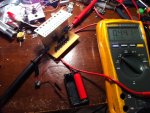- Joined
- Dec 27, 2011
- Messages
- 2,062
- Points
- 48
Instead of running a bunch of diodes in series to create a test load, why not just chose some zeners dialed in at red, blue and violet voltage drops?
Is it a practical matter? Is it too hard to find a 3v Zener that can handle 500mA? Or 4v Zener that can do 4A?
Or am I missing something bigger in the picture?
:thanks:
Is it a practical matter? Is it too hard to find a 3v Zener that can handle 500mA? Or 4v Zener that can do 4A?
Or am I missing something bigger in the picture?
:thanks:






